Mechanical Response and Stability Optimization of Shallow-Buried Tunnel Excavation Method Conversion Process Based on Numerical Investigation
Abstract
:1. Introduction
2. Project Overview and Model Establishment
2.1. Tunnel Geological Conditions
2.2. Excavation Methods and Support Structure
2.3. Model and Parameters
3. Numerical Results
3.1. The Impact of Excavation Method Conversion on Tunnel Response
- (1)
- The DSD method is employed for excavation within the range of ZK10+745-ZK10+705 (no conversion).
- (2)
- The DSD method is employed for excavation within the range of ZK10+745-ZK10+727; the three-bench method is employed for excavation within the range of ZK10+727-ZK10+705 (conversion).
3.1.1. Deformation Analysis of the Surrounding Rock
3.1.2. Stress Analysis of the Support Structure
3.2. Construction Stability Optimization Measures
3.2.1. Leading Conduit Grouting Reinforcement
3.2.2. Parameter Studies of the Reinforced Area
4. Comparison between Field Monitoring and Numerical Results
5. Conclusions
- (1)
- When the excavation method is converted from the DCD method to the three-bench method, the early-stage deformation rate of the surrounding rock accelerates, resulting in the support structure bearing greater pressure.
- (2)
- The excavation method conversion leads to a significant increase in stress at the junction of the DCD method and the three-bench method, with the maximum stress occurring at the left arch foot. Moreover, within one excavation step after the conversion, the early stress at this location has already reached 77.95% of the final stress. Therefore, special attention needs to be paid to the stability at the junction during the conversion process.
- (3)
- Setting up a leading conduit during the process of excavation method conversion can help the support structure bear part of the weight of the rock mass, improving the stress state of the support structure. Both early and final circumferential stresses are reduced under the influence of the reinforced area. This suggests that establishing a reinforced area is an effective measure to enhance the stability of the excavation method conversion process.
- (4)
- Increasing the length, thickness and strength of the reinforced area can further reduce circumferential stress, and its impact on early stress is greater than that on final stress. Based on the parameter studies, the length can be set to 8 m, the thickness to 1.5 m, and the strength should be enhanced as much as possible within the limits allowed by construction. For different engineering projects, it is necessary to adjust the parameters of the reinforced area appropriately to achieve better reinforcement effects.
Author Contributions
Funding
Data Availability Statement
Acknowledgments
Conflicts of Interest
References
- Yin, Z.; Wang, P.; Zhang, F. Effect of particle shape on the progressive failure of shield tunnel face in granular soils by coupled FDM-DEM method. Tunn. Undergr. Space Technol. 2020, 100, 103394. [Google Scholar] [CrossRef]
- Wang, P.; Yin, Z.; Hicher, P.; Cui, Y. Micro-mechanical analysis of one-dimensional compression of clay with DEM. Int. J. Numer. Anal. Methods Geomech. 2023, 47, 2706–2724. [Google Scholar] [CrossRef]
- Zhao, J.; Tan, Z.; Yu, R.; Li, Z.; Wang, X. Mechanical responses of a shallow-buried super-large-section tunnel in weak surrounding rock: A case study in Guizhou. Tunn. Undergr. Space Technol. 2023, 131, 104850. [Google Scholar] [CrossRef]
- Li, R.; Zhang, D.; Fang, Q.; Liu, D.; Luo, J.; Fang, H. Mechanical responses of closely spaced large span triple tunnels. Tunn. Undergr. Space Technol. 2020, 105, 103574. [Google Scholar] [CrossRef]
- Luo, Y.; Chen, J.; Shi, Z.; Li, J.; Liu, W. Mechanical characteristics of primary support of large span loess highway tunnel: A case study in Shaanxi Province, Loess Plateau, NW China primary. Tunn. Undergr. Space Technol. 2020, 104, 103532. [Google Scholar] [CrossRef]
- Xue, Y.; Gong, H.; Kong, F.; Yang, W.; Qiu, D.; Zhou, B. Stability analysis and optimization of excavation method of double-arch tunnel with an extra-large span based on numerical investigation. Front. Struct. Civ. Eng. 2021, 15, 136–146. [Google Scholar] [CrossRef]
- Jiang, Q.; Song, S.-G.; Li, T.; Wang, K.; Gu, R.-H. Study on surrounding rock stability of small clear-distance twin highway tunnel with eight lanes. Geotech. Geol. Eng. 2019, 37, 593–598. [Google Scholar] [CrossRef]
- He, J.; He, S.; Liu, X.; Zheng, J. Structural design and mechanical responses of closely spaced super-span double tunnels in strongly weathered tuff strata. Front. Struct. Civ. Eng. 2022, 16, 685–703. [Google Scholar] [CrossRef]
- Yoo, C. Performance of multi-faced tunnelling—A 3D numerical investigation. Tunn. Undergr. Space Technol. 2009, 24, 562–573. [Google Scholar] [CrossRef]
- Sharifzadeh, M.; Daraei, R.; Broojerdi, M.S. Design of sequential excavation tunneling in weak rocks through findings obtained from displacements based back analysis. Tunn. Undergr. Space Technol. 2012, 28, 10–17. [Google Scholar] [CrossRef]
- Ieronymaki, E.; Whittle, A.J.; Einstein, H.H. Comparative study of the effects of three tunneling methods on ground movements in stiff clay. Tunn. Undergr. Space Technol. 2018, 74, 167–177. [Google Scholar] [CrossRef]
- Hoek, E. Big tunnels in bad rock. J. Geotech. Geoenviron. Eng. 2001, 127, 726–740. [Google Scholar] [CrossRef]
- Yu, C.; Chern, J. Expert System for D&B Tunnel Construction; Underground Space 4th Dimension of Metropolises: London, UK, 2007; pp. 799–803. ISBN 978-0-415-40807-3. [Google Scholar]
- Daraei, A.; Zare, S. A new multi-graph approach for selecting the sequential excavation method of civil tunnels. Tunn. Undergr. Space Technol. 2019, 91, 102999. [Google Scholar] [CrossRef]
- Zhu, H.; Yan, J.; Liang, W. Challenges and Development Prospects of Ultra-Long and Ultra-Deep Mountain Tunnels. Engineering 2019, 5, 384–392. [Google Scholar] [CrossRef]
- Ou, G.-Z.; Jiao, Y.-Y.; Zhang, G.-H.; Zou, J.-P.; Tan, F.; Zhang, W.-S. Collapse risk assessment of deep-buried tunnel during construction and its application. Tunn. Undergr. Space Technol. 2021, 115, 104019. [Google Scholar] [CrossRef]
- Zhang, Z.; Zhao, C.; Peng, L.; Zhang, X.; Lei, M. Research on the stability of shallow-buried large cross-section tunnel by construction method conversion. Front. Earth Sci. 2022, 10, 831169. [Google Scholar] [CrossRef]
- Liu, D.; Zhang, D.; Fang, Q.; Sun, Z.; Cao, L.; Li, A. Displacement characteristics of shallow-buried large-section loess tunnel with different types of pre-supports: A case study of new Badaling tunnel. Appl. Sci. 2019, 10, 195. [Google Scholar] [CrossRef]
- Mei, Y.; Ke, X.; Zhou, D.-B.; Zhang, S.; Yang, T. Study on the whole process application of advanced grouting pipe shed support under urban complex stratum conditions. Geomech. Energy Environ. 2023, 33, 100432. [Google Scholar] [CrossRef]
- Fan, H.; Xu, Q.; Lai, J.; Liu, T.; Zhu, Z.; Zhu, Y.; Gao, X. Stability of the loess tunnel foundation reinforced by jet grouting piles and the influence of reinforcement parameters. Transp. Geotech. 2023, 40, 100965. [Google Scholar] [CrossRef]
- Zhang, D.; Fang, Q.; Hou, Y.; Li, P.; Wong, L.N.Y. Protection of buildings against damages as a result of adjacent large-span tunneling in shallowly buried soft ground. J. Geotech. Geoenviron. Eng. 2013, 139, 903–913. [Google Scholar] [CrossRef]
- Zhao, M.; Lai, H.; Liu, Y. A Study on the Formation Mechanism and Calculation Method of Surrounding Rock Pressure in Shallow-buried Loess Tunnel Considering the Influence of Vertical Joints. KSCE J. Civ. Eng. 2023, 27, 1820–1837. [Google Scholar] [CrossRef]
- Wang, Y.; Xin, Y.; Xie, Y.; Li, J.; Wang, Z. Investigation of mechanical performance of prestressed steel arch in tunnel. Front. Struct. Civ. Eng. 2017, 11, 360–367. [Google Scholar] [CrossRef]
- Hua, J.; Zheng, J. Geological Engineering Handbook; China Architecture & Building Press: Beijing, China, 2018; ISBN 978-7-112-21642-0. (In Chinese) [Google Scholar]
- JTG 3370.1-2018; Specifications for Design of Highway Tunnels. China Communications Press: Beijing, China, 2018. (In Chinese)
- Lei, M.; Zhao, C.; Jia, C.; Shi, C. Study on the geological adaptability of the arch cover method for shallow-buried large-span metro stations. Tunn. Undergr. Space Technol. 2023, 132, 104897. [Google Scholar] [CrossRef]
- JTG/T D70-2010; Guidelines for Design of Highway Tunnel. China Communications Press: Beijing, China, 2010. (In Chinese)
- Morovatdar, A.; Palassi, M.; Ashtiani, R.S. Effect of pipe characteristics in umbrella arch method on controlling tunneling-induced settlements in soft grounds. J. Rock Mech. Geotech. Eng. 2020, 12, 984–1000. [Google Scholar] [CrossRef]
- Wang, H.B.; Lu, P.J.; Zong, Q. Experimental Study on Highway Tunnel Surrounding Rock Reinforced by Small Pipe Pre-Grouting. Adv. Mater. Res. 2011, 250–253, 2617–2621. [Google Scholar] [CrossRef]
- Bao, L. Research on Supporting Effect of Advanced Small Conduit in Soft Rock Tunnel; Huazhong University of Science and Technology: Wuhan, China, 2018. [Google Scholar] [CrossRef]
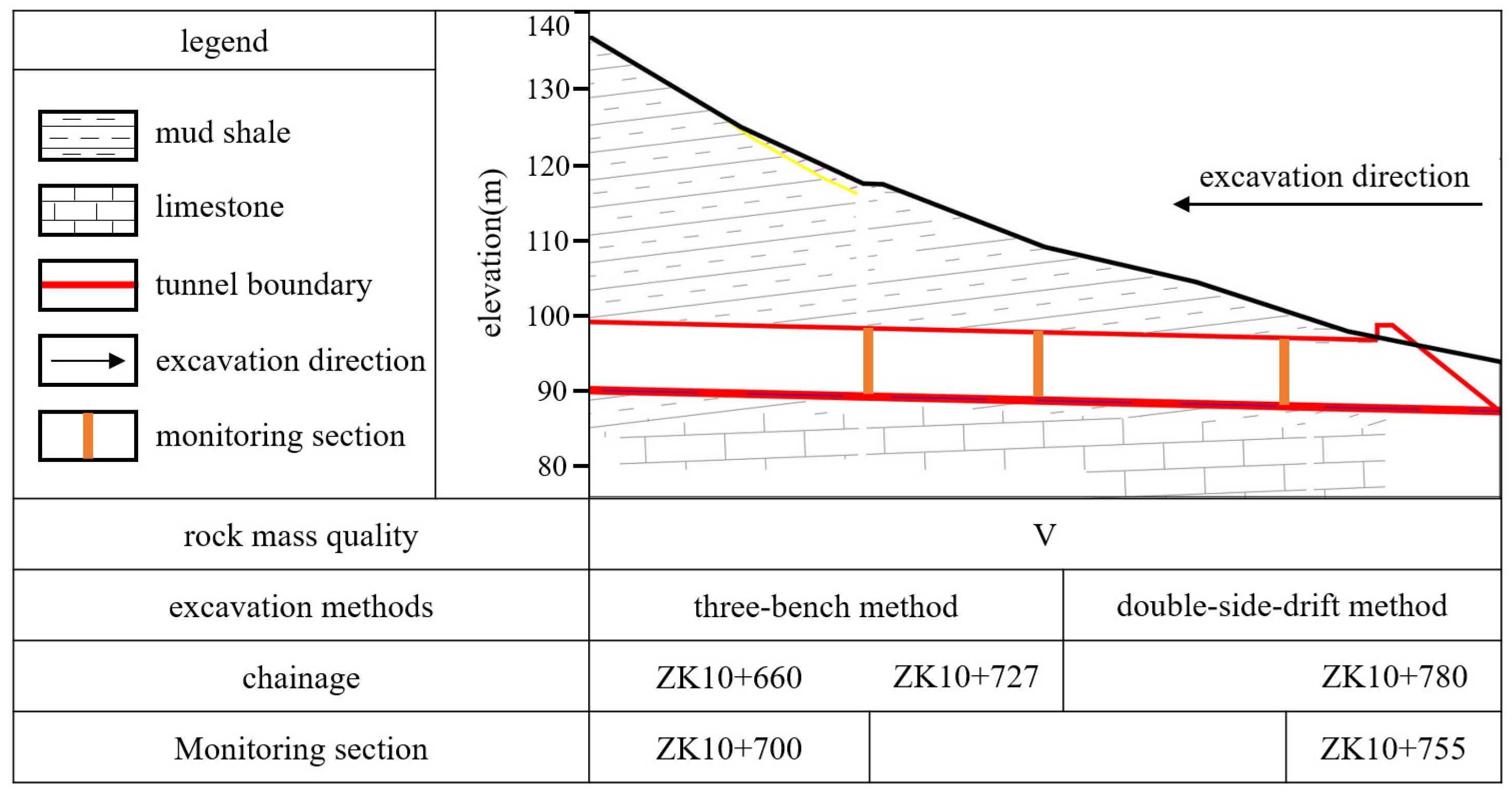
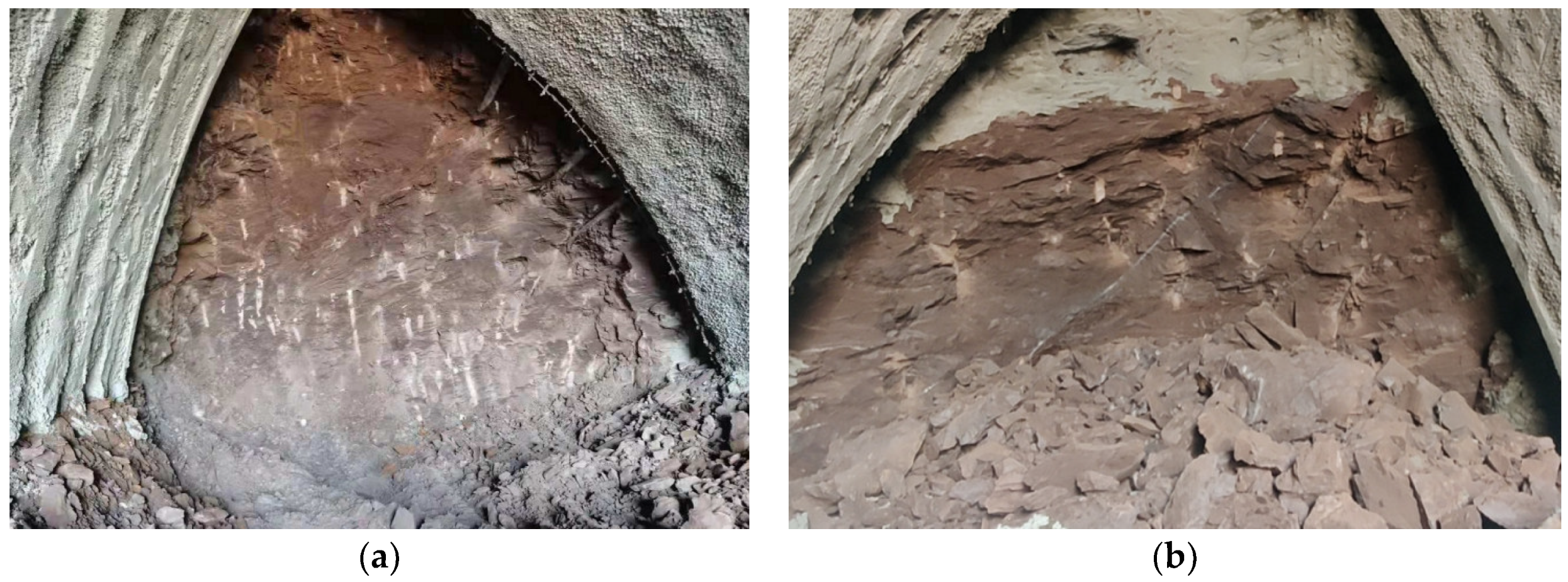
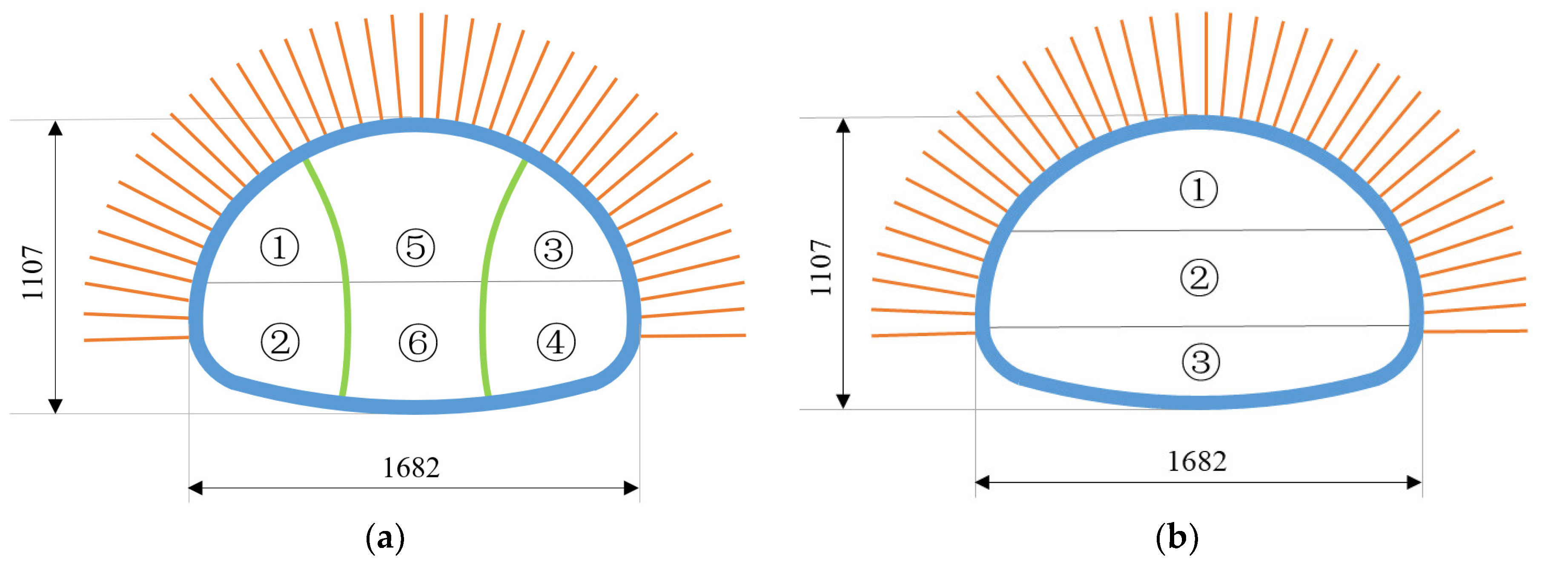




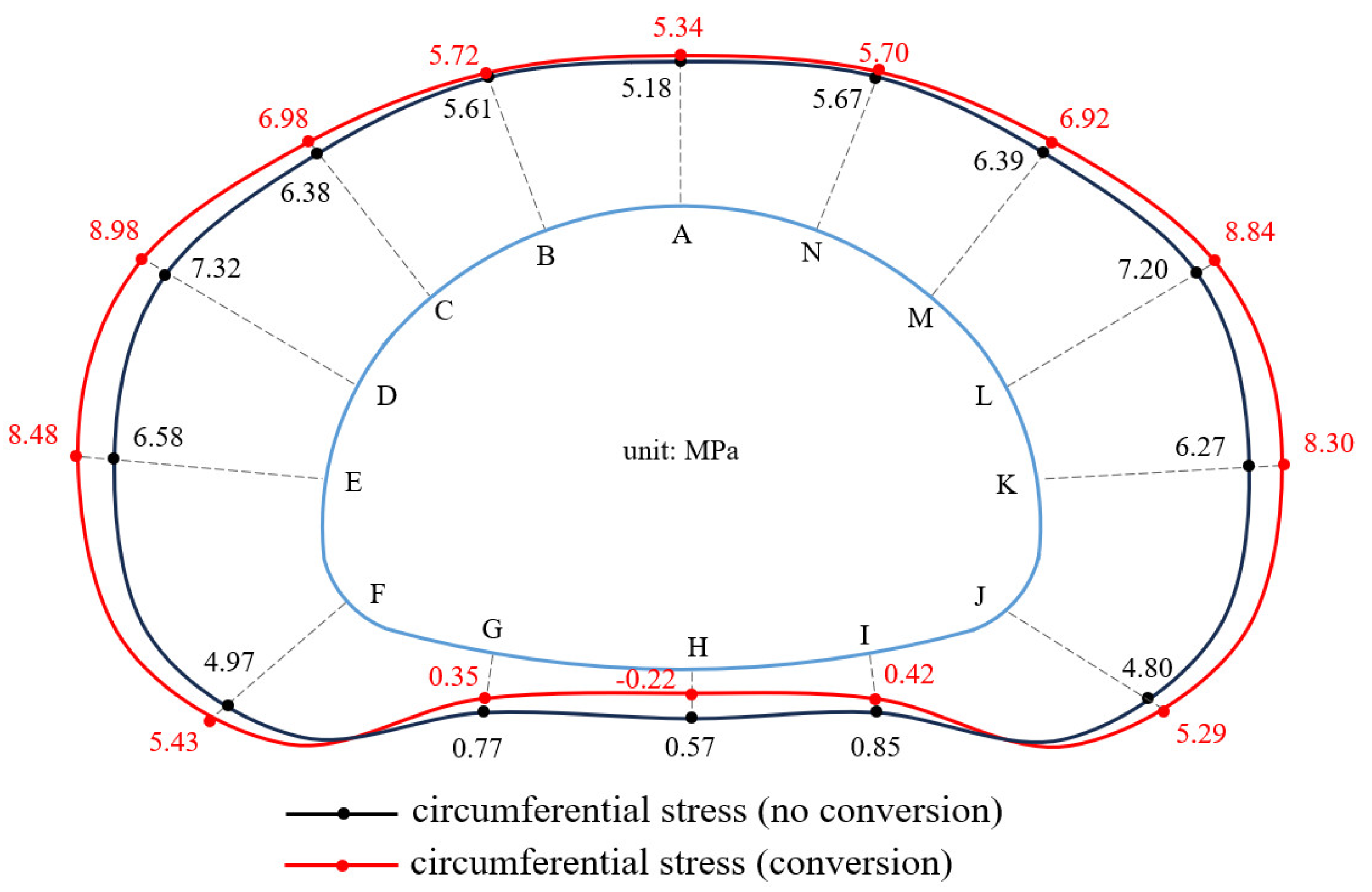
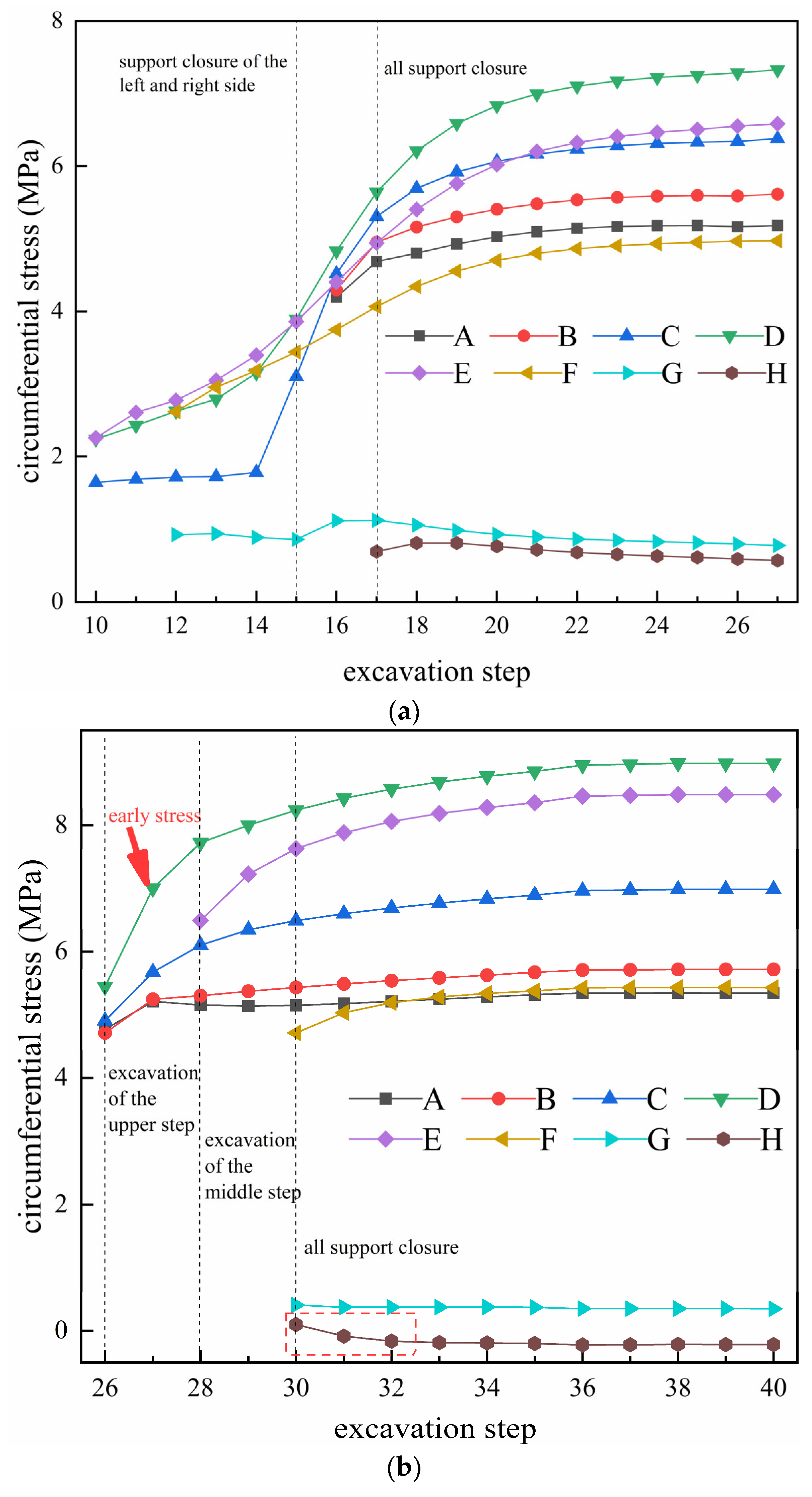
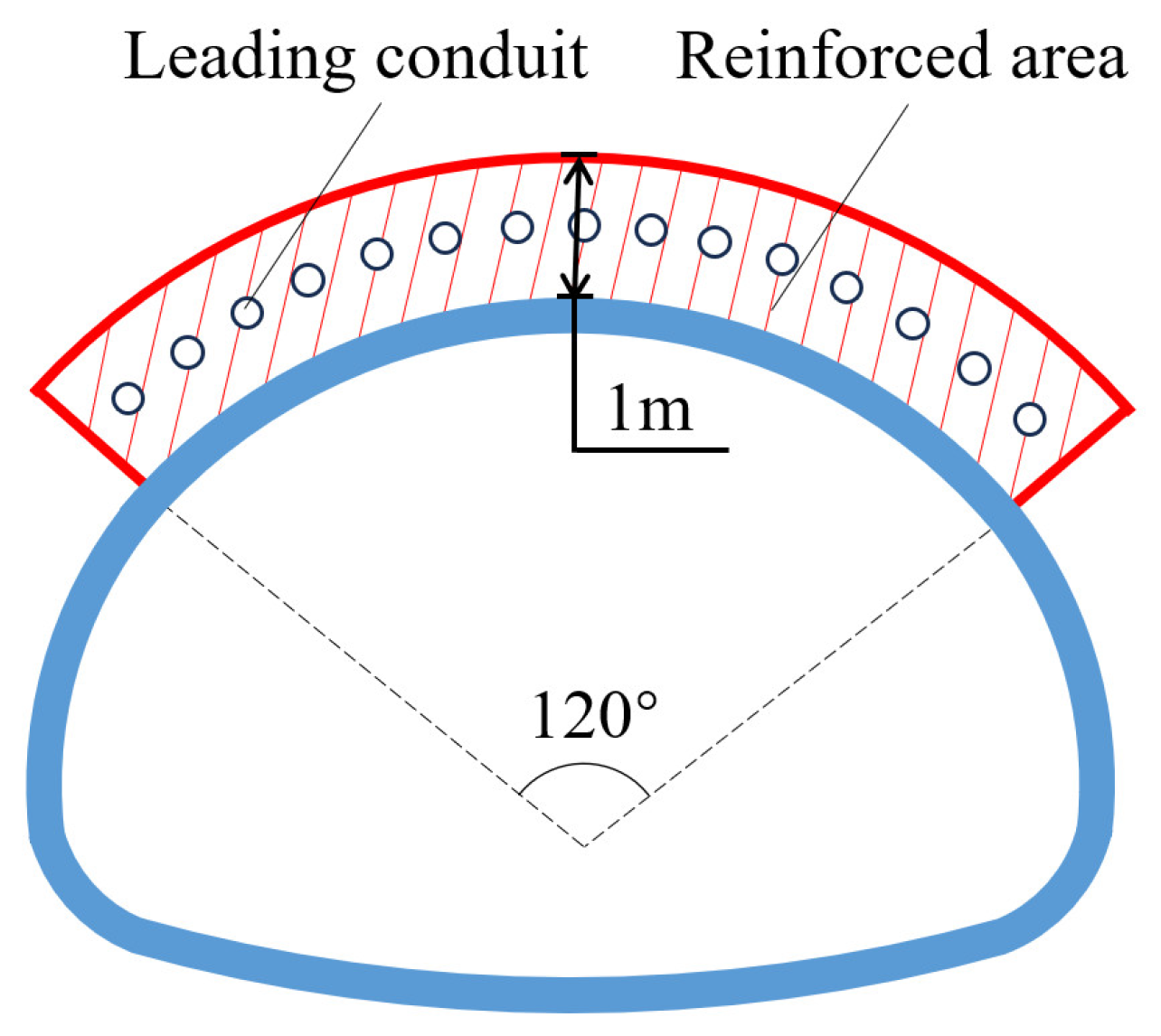

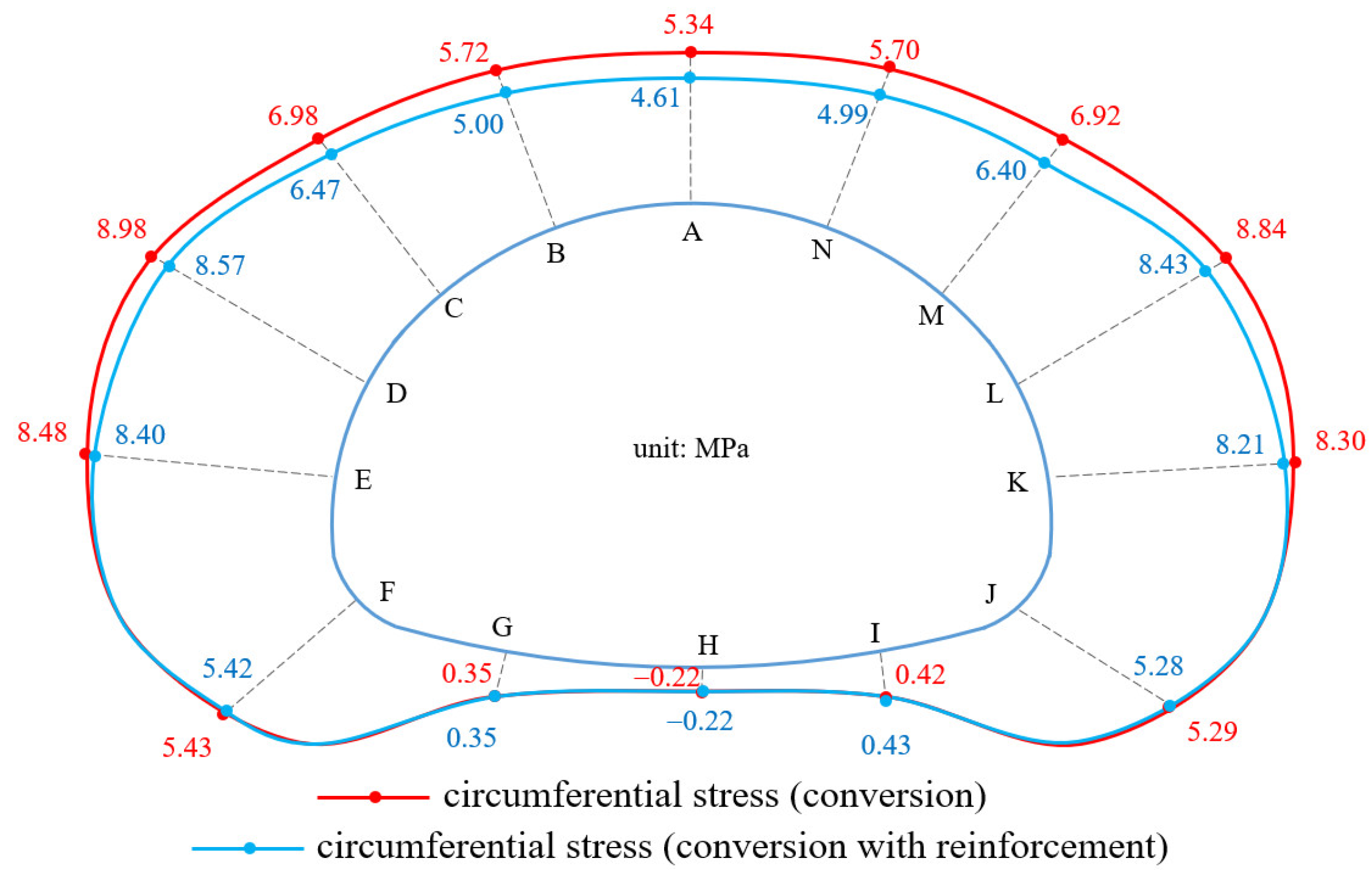
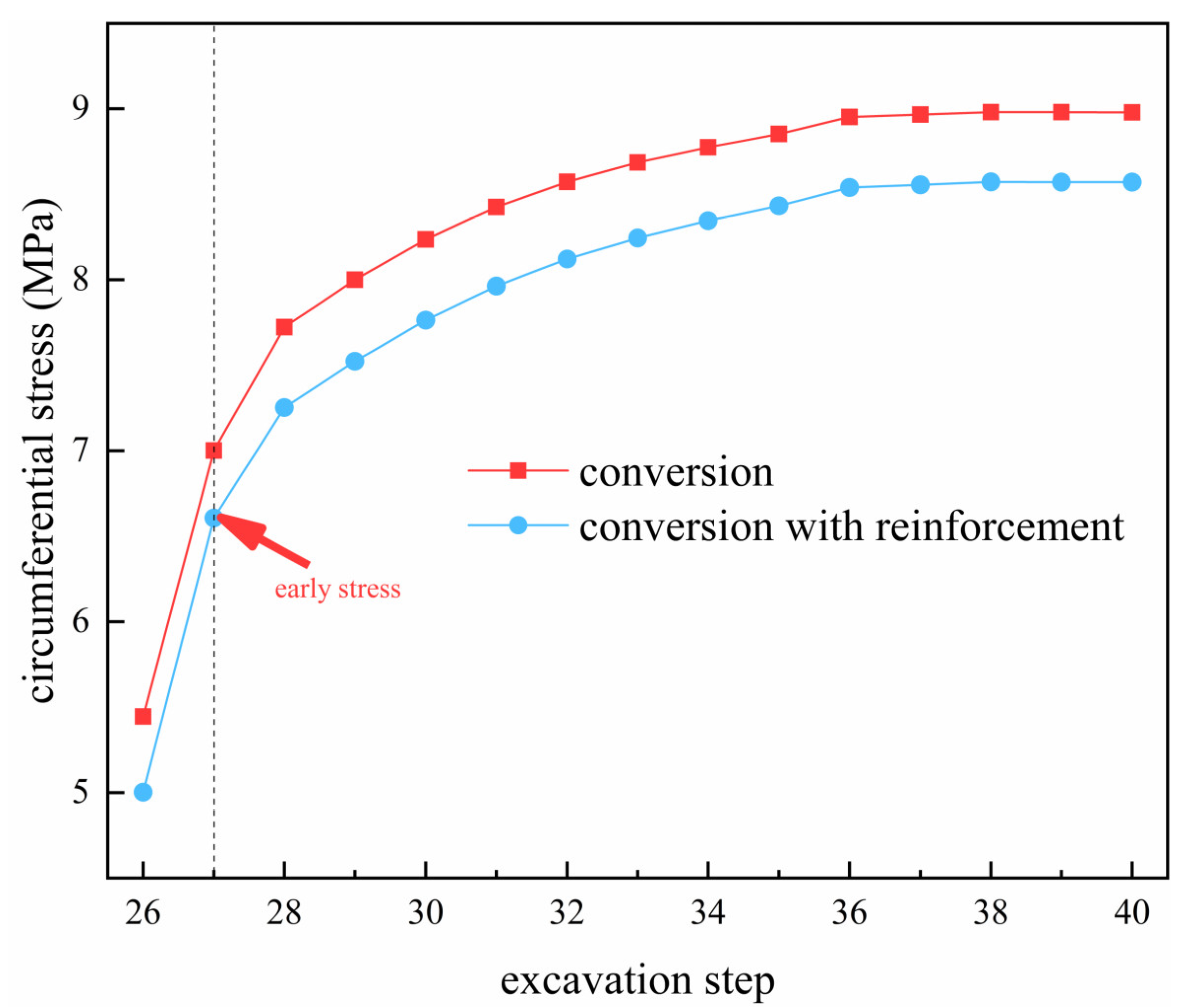

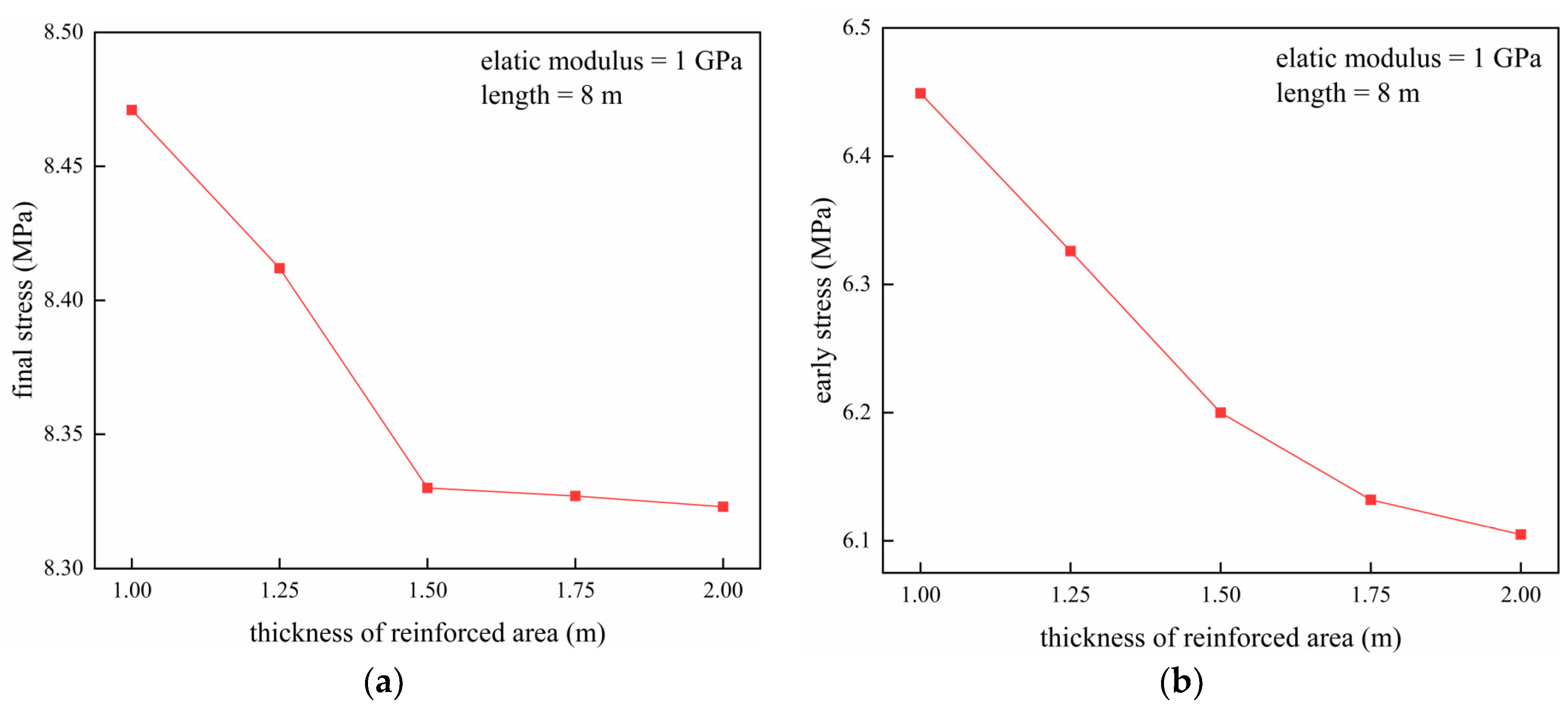


| Name | Gravity Density (kN·m−3) | Poisson’s Ratio | Elastic Modulus (GPa) | Cohesion (kPa) | Internal Friction Angle (°) |
|---|---|---|---|---|---|
| highly weathered mud shale | 22.5 | 0.35 | 0.3 | 200 | 25 |
| moderately weathered mud shale | 23.5 | 0.325 | 1 | 450 | 33 |
| shotcrete | 25 | 0.2 | 28 | / | / |
| temporary support | 25 | 0.2 | 28 | / | / |
| hollow grouting bolt | 78.5 | 0.3 | 210 | / | / |
| Name | Gravity Density (kN·m−3) | Poisson’s Ratio | Elastic Modulus (GPa) | Cohesion (kPa) | Internal Friction Angle (°) |
|---|---|---|---|---|---|
| reinforced area | 24 | 0.3 | 1 | 500 | 30 |
| leading conduit | 78.5 | 0.3 | 210 | / | / |
| Name | Range of Reinforced Area | Length (m) |
|---|---|---|
| 1 | ZK10+729~ZK10+725 | 4 |
| 2 | ZK10+729~ZK10+723 | 6 |
| 3 | ZK10+729~ZK10+721 | 8 |
| 4 | ZK10+729~ZK10+719 | 10 |
| 5 | ZK10+729~ZK10+717 | 12 |
| Name | Setting Angle of the Small Conduit (°) | Thickness (m) |
|---|---|---|
| 1 | 9.2 | 1 |
| 2 | 11.5 | 1.25 |
| 3 | 13.9 | 1.5 |
| 4 | 16.3 | 1.75 |
| 5 | 18.7 | 2 |
| Name | Gravity Density (kN·m−3) | Poisson’s Ratio | Elastic Modulus (GPa) | Cohesion (kPa) | Internal Friction Angle (°) |
|---|---|---|---|---|---|
| 1 | 24 | 0.3 | 1 | 500 | 30 |
| 2 | 24.5 | 0.3 | 1.25 | 500 | 30 |
| 3 | 25 | 0.3 | 1.5 | 500 | 30 |
| 4 | 25.5 | 0.3 | 1.75 | 500 | 30 |
| 5 | 26 | 0.3 | 2 | 500 | 30 |
Disclaimer/Publisher’s Note: The statements, opinions and data contained in all publications are solely those of the individual author(s) and contributor(s) and not of MDPI and/or the editor(s). MDPI and/or the editor(s) disclaim responsibility for any injury to people or property resulting from any ideas, methods, instructions or products referred to in the content. |
© 2024 by the authors. Licensee MDPI, Basel, Switzerland. This article is an open access article distributed under the terms and conditions of the Creative Commons Attribution (CC BY) license (https://creativecommons.org/licenses/by/4.0/).
Share and Cite
Pan, R.; Zhou, B.; Jiang, D. Mechanical Response and Stability Optimization of Shallow-Buried Tunnel Excavation Method Conversion Process Based on Numerical Investigation. Buildings 2024, 14, 1213. https://doi.org/10.3390/buildings14051213
Pan R, Zhou B, Jiang D. Mechanical Response and Stability Optimization of Shallow-Buried Tunnel Excavation Method Conversion Process Based on Numerical Investigation. Buildings. 2024; 14(5):1213. https://doi.org/10.3390/buildings14051213
Chicago/Turabian StylePan, Rui, Baoliang Zhou, and Dongju Jiang. 2024. "Mechanical Response and Stability Optimization of Shallow-Buried Tunnel Excavation Method Conversion Process Based on Numerical Investigation" Buildings 14, no. 5: 1213. https://doi.org/10.3390/buildings14051213




